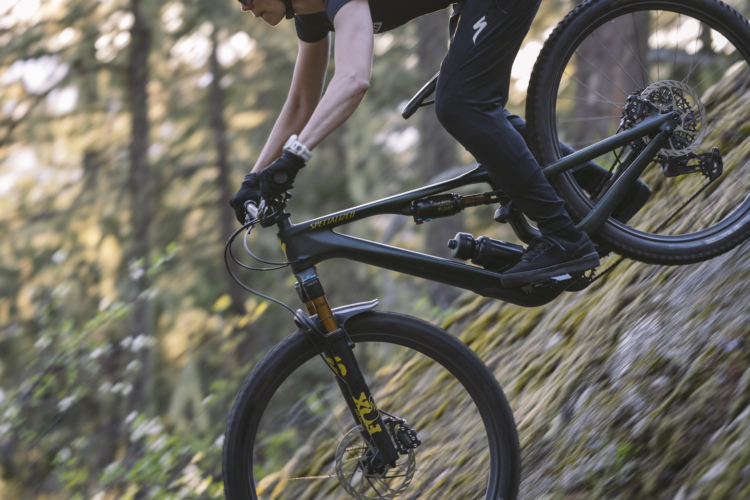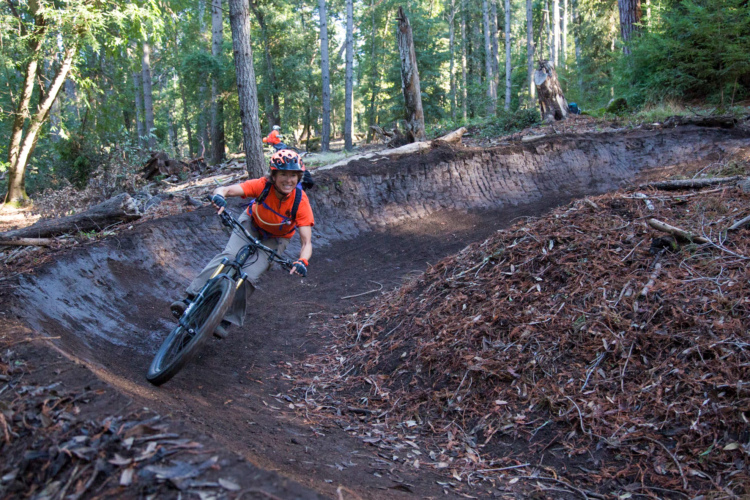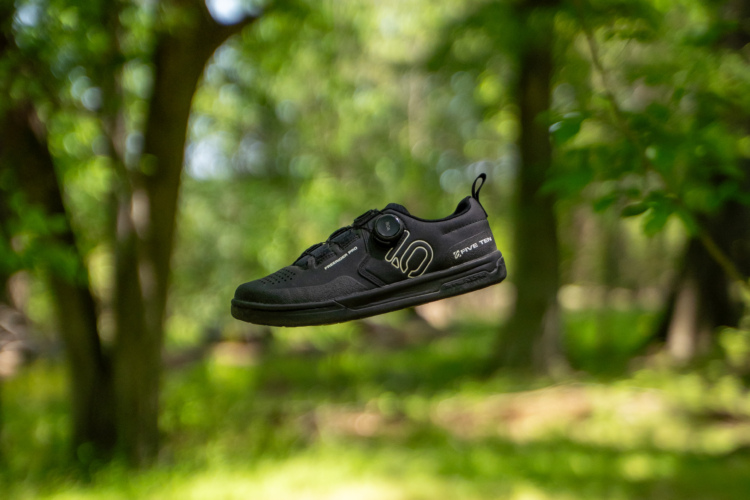
After retiring a legion of fancy electric clippers that promised everything from fewer shaves to youthful looks, I’ve finally landed on the basic safety razor. Something about “what’s not broken…”?
Similarly, what the fork more could ya need than a 130/140mm mountain bike for most trails? You don’t have to choose with the new Ibis Ripley and Ripmo. Both models use the same frame, swapping clevis, fork, and shock to bump a Ripley up from 140mm front and 130mm rear to the Ripmo’s 160/150mm stature. Both bikes can also take a dual 29er or mixed-wheel configuration, as you prefer, thanks to a built-in flip chip.
Ibis Ripley key specs
- 140/130mm travel front/rear
- Price: $4,999 – $8,199 ($6,999 as tested)
- Buy from Ibis dealers including JensonUSA


The build
We received the new Ripley 29er for review, with a sensible Shimano XT and Fox build combo that should suit most riders well. Speaking of shaving things, the bike feels notably lightweight in hand, and our size “extra medium” (XM) build tips the scale at an impressive 31.5lb with a set of pedals installed. The brand reached that number with an in-line shock and EXO tire casings that some riders may swap for burlier parts, but it’s nice to see a stock trail bike come in close to 30lb once more!
In addition to the trustworthy Shimano XT drivetrain and four-pot stoppers this build includes matchy Fox Factory suspension front and rear. The included BikeYoke dropper has become an industry standard for blingy bikes, and for good reason. Top to bottom, this is a solid build with serviceable components that fit the bike’s intentions to the letter.
As usual, the XT brake pads rattled and made heaps of noise on rough descents, or generally any time I let off the brakes. Spreading the pad spring solved that, but it would be fantastic if Shimano could do that work for us.
Ibis made a notable summer-selection for the Ripley’s tread, opting for a Maxxis Recon rear and Minion DHR II front. The rear tire should keep things fast and light through dry weather, wearing just in time to throw that DHR II on the back and replace it with choice wet weather rubber below the bars.
Have you ever picked up a loaf of bread to find that it’s far more dense and heavy than expected? The Ibis Send wheels create a similar allusion regarding overall width. They claim a 35mm-wide internal measurement, but tires look wider on these than they do on comparable wheels and the rim profile also appears to have a broader stance. Fortunately, that burliness doesn’t hamper the bike’s overall weight. These wheels felt plenty stiff and responsive throughout testing, and the alloy rims didn’t flinch or fold following some significant stone strikes.
The carbon Blackbird HiFi handlebar offers a unique feature with a pair of inserts that riders can remove or cut to fit. At stock length, the inserts will leave the handlebar at 800mm, and 750mm once removed. The ability to cut these replaceable inserts instead of chopping the carbon bar is a lovely bonus for anyone who might eventually sell this bike or the handlebar.



The Ibis Ripley v4 frame
Ibis added a snack pocket to the DW-Link driven Ripley and Ripmo, with pouches to keep your sandwich and tools quiet inside the downtube. The door latch is about as user-friendly as they get, with one simple movement to access the gods. It’s a clean and quiet solution and feels ready to hold up through years of use.

Industrial designers spend more time than they’d admit shaving weight and angles from frame protection to make it look sleek, not detract from the frame’s overall aesthetic, and still do its actual job. The rubber on this frame’s BB, downtube, and chainstay is sleek and refined and the chain remains silent. That’s a whole heap of wins for a few pieces of rubber.
Finally, Ibis slapped another slice of rubber where the two triangles cross at the BB to keep them from eating rocks. No stones for breakfast! Frame pinch points are a warranty issue for countless carbon bikes and this solution looks to save all that hassle.
This DW-driven design forgoes the chain guide, depending on the derailleur clutch for chain retention, and like most new bikes the derailleur bolts to a UDH dangler making the bike compatible with all of the latest drivetrain robots.

Geometry
All face hairs are not shaven equally. Also, not every rider’s height fits the same geometry. The engineers at Ibis listened to customer feedback and designed accordingly, with size-specific geo in a number of corners.
Seat tube angles lean to 77.4° on the size small frame, and tilt forward on each larger option. Taller riders were reporting more frequent pedal strikes while climbing, so Ibis gave the new Ripley and Ripmo a 3mm BB-height raise between each size, starting at 326mm on the small.
| Small | Medium | Extra medium | Large | Extra Large | |
|---|---|---|---|---|---|
| Seat tube length | 395 | 400 | 416 | 457 | 477 |
| Top tube length | 577 | 604 | 629 | 654 | 684 |
| Chainstay length (29) | 436 | 436 | 437 | 440 | 442 |
| Chainstay length (MX) | 433 | 433 | 434 | 436 | 438 |
| Seat tube angle | 77.4° | 76.9° | 76.9° | 77.4° | 77.9° |
| Saddle height | 650 | 700 | 745 | 790 | 830 |
| Head tube angle | 64.9° | 64.9° | 64.9° | 64.9° | 64.9° |
| Wheelbase | 1187 | 1211 | 1241 | 1279 | 1321 |
| Stack | 613 | 619 | 629 | 640 | 650 |
| Reach | 440 | 460 | 483 | 511 | 545 |
| Bottom bracket height (29) | 326 | 329 | 332 | 335 | 338 |
| Standover | 680 | 721 | 744 | 759 | 772 |
In the longhair department, reach gets stretchy on these rides. The size extra-medium we tested has a reach of 483mm, and it feels as long as it is. For reference, a size large on the previous Ripley had a reach of 475mm. To balance it all, chainstays also lengthen slightly across the size run, though not dramatically. The largest leap is a mere 3mm between the XM and large sizes.
Finally, the headtube on this short travel tot is a legit 64.5°, leaning back for steep fun whenever you want it. It’s refreshing to see springy little bikes like this one with proper gravity headtube angles for the rowdy party.
Climbing
Yup, it goes up. The lighter weight of the Ripley is evident on first ascent, leaving all of my climb-timing onus on fitness. The weight feels well balanced, leaving the bike maneuverable in technical rooty moves where you want your wheels to obediently follow your body movements.
While the seat tube angle isn’t as steep as some, it feels appropriately placed above the BB. That slightly more rearward saddle does make the long reach measurement noticeable. Despite sliding the saddle forward, I felt more stretched out on the Ripley than I have with other bikes of similar size. This is something folks will get used to, but it’s a standout piece of the first few pedals.
What little pedal-bob existed was quickly squelched by the shock’s climb switch, which I opted to flip on nearly every ascent. The shock feels a bit under-damped for my preferences and I had to run less static sag than I typically would to achieve a cozy ride height and support. A few tokens and more pressure should move the needle where it needs to be, but the stock tune was generally a bit tepid for my taste. Riders who like a max-plush pedal with no trail feel whatsoever will likely love this tune.
The Ripley’s rear tread tracks well up technical climbs, and I would unquestionably grab this bike for long slogs in the alpine where efficient uphill is desirable. Having ridden the extra-medium, I would opt for the medium size with its 460mm reach for a better body fit. Apart from that measurement, the Ripley maintains the signature Ibis climbing prowess the brand has long been known for.

Descending
Now for the (other) fun part! All that marshmallow squish makes for a carpet ride downhill. The shock’s light compression and rebound tune create a lively ride feel that’s pillowy smooth, especially for a shorter travel trickster. The rebound adjustment range should suit most riders’ needs, running fast across the board to get that wheel back in contact with the earth. The shock tune pairs well with the bike’s Fox 34 fork for a well-balanced bump muncher.
Share your Ibis Ripley review
I did find the bottom of this shock quite easily on some rougher trails, despite running about 20% sag. This too could be sorted with a few volume spacers in the shock. It could also be remedied by converting the Ripley to a Ripmo, giving it a longer axle path to appropriately slam into the forest ahead.
Lofting the Ripley was exciting the first few times. I haven’t ridden or jumped a bike this light in a few years, and it’s definitely a different animal. I had to adjust trail speed and my physical input a bit compared to my usual 38lb enduro sled. After sniffing one another for a bit, the Ripley and I got on well in the air. My favorite lips feel good aboard this bike, provided the landings are travel-appropriate.
The Ripley feels best on blue to double-blue-diamond (Canadian Blue) descents where you might expect a 130mm platform to shine. It’s a fantastic trail bike that leans hard in the gravity direction while maintaining all the goat character we want in a premium carbon bike.
Pros and cons of Ibis Ripley
Pros
- Light weight
- Solid build
- Gravity geo with shorter travel
- Quiet in-frame storage
Cons
- Compression tune may be too light for some
- Tires are summer-only if your trails are steep
Bottom line
Anyone in search of a lightweight mid-travel bike that has the angles to descend will be stoked on a new Ripley. The ability to swap travel and rear-wheel sizes is a stellar bonus for folks who appreciate adaptability in their toys, and for anyone with frame storage on their “must have” list, Ibis checked that box with a fat permanent marker.
This is a true trail bike, not one of those mid-travel rigs that can tackle all the big-bike terrain. If that’s what you’re after, the Ripmo might suit your fancy.





















5 Comments
Jul 16, 2024
Jul 17, 2024
Jul 19, 2024
Jul 19, 2024
Jul 18, 2024
We had a couple of years with bikes trending lighter (finally) but it seems to have taken a uturn starting with the new Fuel EX.